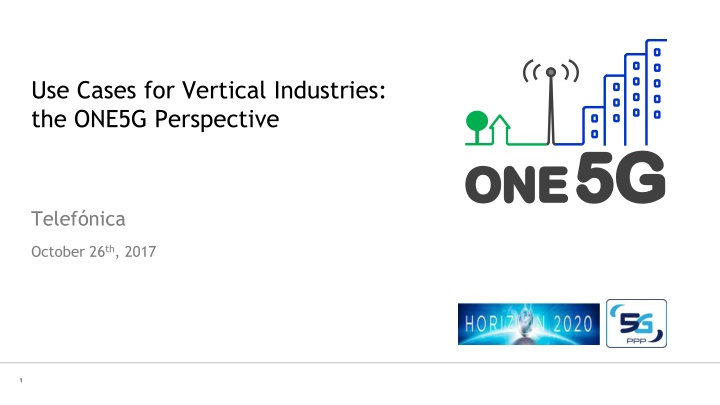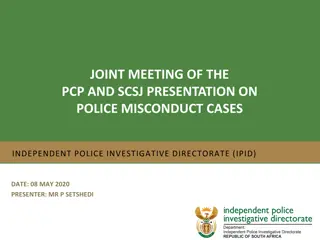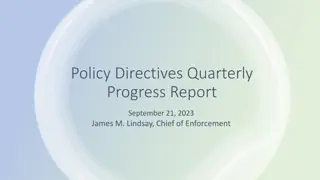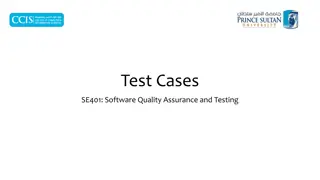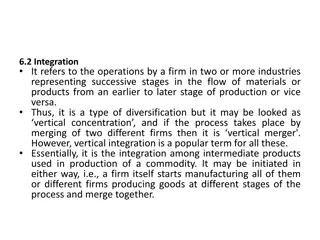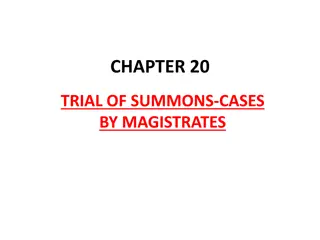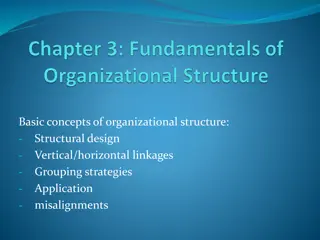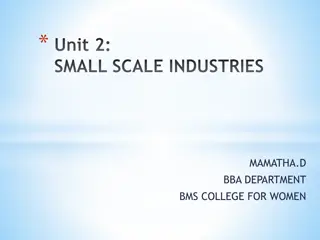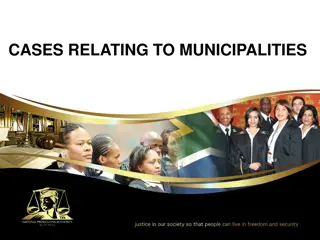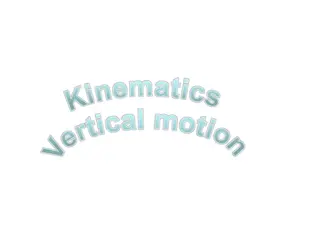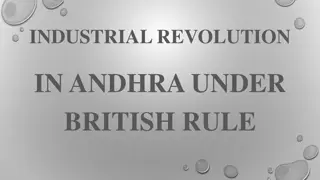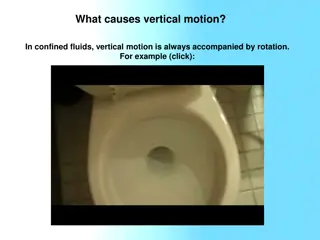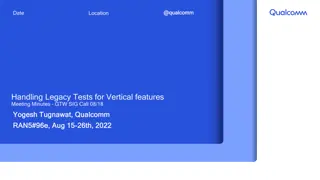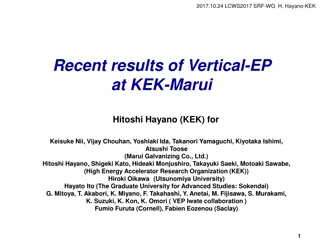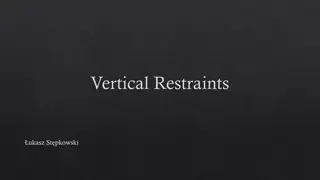ONE5G: Use Cases for Vertical Industries in 5G Perspective
The ONE5G project focuses on E2E optimizations and advancements for 5G network edge, beyond the initial 3GPP Release 15. It addresses advanced air-interface technologies, aiming to enhance user experience and network operator performance. TWO major scenarios analyzed are Megacities and Underserved Areas. Objectives include PoCs, standardization, and dissemination for moving towards 5G advanced.
Download Presentation

Please find below an Image/Link to download the presentation.
The content on the website is provided AS IS for your information and personal use only. It may not be sold, licensed, or shared on other websites without obtaining consent from the author.If you encounter any issues during the download, it is possible that the publisher has removed the file from their server.
You are allowed to download the files provided on this website for personal or commercial use, subject to the condition that they are used lawfully. All files are the property of their respective owners.
The content on the website is provided AS IS for your information and personal use only. It may not be sold, licensed, or shared on other websites without obtaining consent from the author.
E N D
Presentation Transcript
Use Cases for Vertical Industries: the ONE5G Perspective Telef nica October 26th, 2017 1
ONE5G: E2E-aware Optimizations and advancements for the Network Edge of 5G New Radio The European-funded 5GPPP project ONE5G tackles the design of advanced air-interface technologies and optimizations from an end-to-end (E2E) perspective for 5G, beyond the first standard release (3GPP Release 15) - 14 partners, 8 M and 2 years (5G PPP Phase 2) - Coordinator: Nokia Bell Labs (Frank Schaich) The project aims at researching advanced link enhancements beyond Release 15, moving 5G to 5G advanced , including optimizations for both the network operator and the E2E user-experienced performance, with special focus on verticals This contribution presents an agreed set of scenarios, use cases, services and associated KPIs corresponding to several of the most promising verticals The slideset is available for download at the Project s web page: https://one5g.eu/ 2
Two scenarios are considered: Megacities and Underserved Areas A scenario is defined as a particular environment where certain conditions are met (in terms of urban furniture, orography, access to public infrastructure, density of users, etc.) ONE5G is currently analyzing two broad scenarios: - Megacities, a highly populated metropolitan area, characterized by: - High-end customers (individual and businesses) - High area throughputs and connection densities - Underserved Areas, with insufficient or no wireless connection at all, because of: - Insufficiently attractive business case - Challenging operational conditions 3
Objectives Scenarios PoCs Dissemination Standard Underserved Areas Megacities Cost technical recommendations for moving 5G TA1 - Future proof multi-service access solutions Link enablers System-Level simulations and PoCs Cost analysis and optimization towards 5G advanced TA2 - Massive MIMO enablers Dissemination TA3 -Advanced link management based on multi- cell processing E2E performance TA4 - Optimized multi-link management for improved E2E performance TA5 - Network and user-experienced E2E performance optimization and context awareness Obj.7 : To produce a high number of valuable contributions to relevant conferences and printing media (>50), a reasonable amount of IPR (>10) and partner specific standardization contribution 4
ONE5G has identified seven most promising verticals 3 2 4 + Smart Cities + Transport and Logistics + Wellness 5 1 + eOffices + + 6 7 Agriculture 5 Disasters & Public Safety
Use cases are characterized by a set of requirements in the form of Key Performance Indicators (KPIs) Use Case Vertical business Level of maturity w.r.t. 3GPP/other Service categories No. Cooperative driving between vehicles and between them and infrastructure Automotive High (TR 22.886) all 1 Assisted, cooperative and tele-operated driving Factories, Transport and Logistics High (TS 22.261) all 2 Time-critical factory processes and logistics optimisation (industry and smart airports) Smart Cities and Energy High (TR 45.820 and TR 38.913) mMTC 3 Non time-critical processes and logistics (factories and smart cities) Long range connectivity in remote areas with smart farming application Agriculture High (TR 38.913) eMBB, mMTC 4 Media, Entertainment and eOffice High (TR 38.913, TS 22.261, ) eMBB 5 Outdoor hotspots and smart offices with AR/VR and media applications Media, Entertainment and eOffice High (TS 23.246, TS 26.346, ) eMBB 6 Live Event Experience eHealth and Wellness Low mMTC, UR(LL)C 7 Health/wellness monitoring Smart Cities and Energy Med (eg: TR 45.820 and TR 38.913) mMTC 8 Smart grid, connected lighting and energy infrastructure Disasters and Public Safety High (Study Item on NR to support non-terrestrial networks) eMBB/mMTC 9 Ad-hoc airborne platforms for disasters and emergencies 6
Most relevant KPIs in Assisted/co-operative/tele-operated driving Megacities/Underserved Areas 3 service types are considered: 1. The roadside units (RSU) will enable ultra-high reliability and very low latencies but vehicles will be able to communicate even without this support. 2. Cooperative driving between nearby vehicles Car-to-car (or V2V) communications, again URLLC requirements plus data integrity and rapid authentications. This will allow communications even without network support. 3. Tele-operated driving Remote driving capability for situations where human operations are too hazardous or impractical. URLLC requirements for controlling the vehicle but also eMBB in the uplink to view UHD/3D video to facilitate operational success. Key parameters: Assisted driving aided by roadside infrastructure - URLLC U plane reliability (99.999%), U plane min. E2E latency (5ms for service #1, 1ms for service#2). - Carrier freq.- below 6GHz (likely ETSI ITS bands), bandwidth up to 200MHz for eNB, 100MHz for RSU/ V2V - Cell sizes 500m for urban, 1732m for underserved (highways), supporting up to 1000 vehicles - Tx powers eNB-46, RSU-23, UE-23 dBm, Antenna configs eNB upto 256, UE upto 8. 7
Feasibility of the requirements in light of 3GPP Release 15 progress The main concern is the reliability dimension that is implicit in many of the selected use cases - E.g.: 99.999%, 99.9999% and even higher are being considered for use cases 1 and 2 - Release 15 will support low-latency, but reliability aspects will not be fully developed until Release 16 Latency can be met by bringing network functions (RAN + Core) close to the user - MEC, and the use of mini-slots in NR, will help reduce latencies However, ad-hoc deployments tailored to specific needs (like e.g. reduced latency) are not cost- effective The wide range of KPIs demands proper support of end-to-end network slicing - However, little progress is expected in Release 15 - The impact of slicing on the RAN (including devices) is still unclear, but should be fully developed in Release 16 8
Summary and conclusions Nine use cases are proposed in ONE5G that capture the most promising 5G applications All of them try to illustrate how lifes and work can benefit from 5G (in aspects such as transport, industries, smart cities, agriculture or entertainment, to name a few) Supporting many of these use cases requires careful attention to latency and reliability aspects These topics will be considered in Release 16 for submission to IMT-2020, and companies in ONE5G will make contributions to the 3GPP Working Groups and other SDOs based on the technical work carried out in the project 9
References 3GPP TR 38.913, Study on scenarios and requirements for next generation access technologies 3GPP TR 22.886, Study on enhancement of 3GPP support for 5G V2X services 3GPP TR 22.261, Service requirements for next generation new services and markets 3GPP TR 22.891, Feasibility Study on New Services and Markets Technology Enablers (SMARTER) 5G PPP Infrastructure Association: White Paper on Factories of the Future, available at: https://5g-ppp.eu/wp-content/uploads/2014/02/5G-PPP-White-Paper-on-Factories-of-the-Future- Vertical-Sector.pdf NGMN Alliance White Paper on 5G Requirements, 2015. Available at: https://www.ngmn.org/uploads/media/NGMN_5G_White_Paper_V1_0.pdf Siemens position paper 5G communication networks: Vertical industry requirements , available at: http://www.virtuwind.eu/_docs/Siemens_PositionPaper_5G_2016.pdf 10
Annex I: Details on the terminology, verticals and use cases 11
Terminology: service categories, use cases, services A service category is a set of services that share some common characteristics in terms of connectivity - Three categories defined by ITU: eMBB, mMTC and URLLC (FWA is sometimes added as a fourth one) - Services within each category may not have the same KPIs, but at least they share some basic parameters A use case is a real-life application that can cover one or more service categories (eMBB, mMTC, URLLC) - A given use case can support different services, belonging to one or more service categories A service can be provided within a use case and scenario, with particular characteristics in terms of KPIs - E.g. UR/VR applications, UHD video, factory control, etc. - Each service should have clearly identified KPIs 12
and vertical businesses/applications A vertical business/application is a set of services that also share some characteristics, although not necessarily linked with connectivity - E.g. the Automotive vertical comprises services from all three categories: infotainment (eMBB), driving assistance (URLLC), sensors (mMTC) ONE5G has identified seven most promising verticals: - Automotive: communications between vehicles and between them and pedestrians, roadside and network infrastructure - Factories, Transport and Logistics: automation of factories to provide substantial efficiency gains, thanks to the optimization of processes - Smart Cities and Energy: smart utilities and energy supply infrastructure, with very large densities of sensors (thousands/km2) and tight constraints on battery life (several years) and reliability - Agriculture: smart farming applications addressing sensors over very long ranges (tens of km) - eHealth and Wellness: critical health monitoring or watch-dogging disadvantaged people - Media, Entertainment and eOffice: gaming applications, Live Events, AR/VR and Smart Offices - Disasters and Public Safety: ad-hoc network deployments for disasters, using drones, HAPs, etc. 13
Six Core 5G use cases with major relevance and societal impact - Assisted, cooperative and tele-operated driving - Assisted driving aided by roadside infrastructure, cooperative driving between vehicles and between them and infrastructure, and remote driving - Time-critical factory processes and logistics optimization (industry and smart airports) - Factory/process automation, motion control, automated guided vehicles/robots, and smart transport hub - Non time-critical processes and logistics (factories and smart cities) - Production and logistics processes, quality control for factories, traffic/pollution management, city automation - Long range connectivity in remote areas with smart farming application - Provision of basic services to remote areas over long distances, including automated/smart farming for crops, livestock - Outdoor hotspots and smart offices with AR/VR and media applications - Outdoor/Indoor hotspots in dense urban areas and city centers, including smart indoor/home offices - Live Event Experience - AR/VR and video streaming over live events with large user densities 14
plus three Secondary 5G use cases with significant potential - Health/wellness monitoring - Health-related services, like measurement of patient s health status or watch-dog devices for elder people - Smart grid, connected lighting and energy infrastructure - Reliable data collection and transmission for efficient interaction with the electricity smart grid - Ad-hoc airborne platforms for disasters and emergencies - Drones or High-Altitude Platforms (HAP) for messaging, AR/VR and assistance in disaster situations The set of nine use cases comprise the main 5G use cases that are foreseen to be most relevant over the identified vertical businesses Each use case is characterized by a set of requirements in the form of Key Performance IndicatorsKPIs (see Annex) - KPIs can either refer to part of the deployment (e.g. radio segment), or be specified E2E In addition, Key Quality Indicators (KQIs) can better characterize the E2E performance 15
Objectives Scenarios Obj.1 : Propose the necessary 5G extensions, from the performance and cost perspectives, in order to address the two selected scenarios Underserved Areas Megacities 17
Objectives Scenarios Underserved Areas Megacities TA1 - Future proof multi-service access solutions Link enablers Obj.3 : Propose advanced link technologies and enhancements beyond Rel.15 to enable multi-service operation and practical implementation of 5G advanced (pro) , with future-proof access schemes, advanced Massive MIMO enablers and link management TA2 - Massive MIMO enablers TA3 -Advanced link management based on multi- cell processing 18
Objectives Scenarios Underserved Areas Megacities TA1 - Future proof multi-service access solutions Link enablers TA2 - Massive MIMO enablers TA3 -Advanced link management based on multi- cell processing E2E performance TA4 - Optimized multi-link management for improved E2E performance Obj.4 : Develop highly generic performance optimization schemes for 5G NR, in order to achieve successful deployment and operation, including optimizations for both the network operator and the E2E user-experienced performance TA5 - Network and user-experienced E2E performance optimization and context awareness 19
Objectives Scenarios Underserved Areas Megacities Cost TA1 - Future proof multi-service access solutions Link enablers Cost analysis and optimization TA2 - Massive MIMO enablers Obj.5 : To identify the cost driving elements for the roll-out and operation and to propos adaptations to allow sustainable provision of wireless services in underserved areas under constrained circumstances TA3 -Advanced link management based on multi- cell processing E2E performance TA4 - Optimized multi-link management for improved E2E performance TA5 - Network and user-experienced E2E performance optimization and context awareness 20
Objectives Scenarios PoCs Underserved Areas Megacities Cost TA1 - Future proof multi-service access solutions Link enablers System-Level simulations and PoCs Cost analysis and optimization TA2 - Massive MIMO enablers Obj.6 : To validate the developed extensions and modifications through different approaches : analytically, by means of extensive simulations and with proof-of- concepts for selected aspects TA3 -Advanced link management based on multi- cell processing E2E performance TA4 - Optimized multi-link management for improved E2E performance TA5 - Network and user-experienced E2E performance optimization and context awareness 21
Objectives Scenarios PoCs Standard Underserved Areas Megacities Cost technical recommendations for moving 5G TA1 - Future proof multi-service access solutions Link enablers System-Level simulations and PoCs Cost analysis and optimization towards 5G advanced Obj.2 : Build consensus and provide technical recommendations for moving 5G towards 5G advanced (pro) , for input to 3GPP for Releases 16 and 17 TA2 - Massive MIMO enablers TA3 -Advanced link management based on multi- cell processing E2E performance TA4 - Optimized multi-link management for improved E2E performance TA5 - Network and user-experienced E2E performance optimization and context awareness 22
Objectives Scenarios PoCs Dissemination Standard Underserved Areas Megacities Cost technical recommendations for moving 5G TA1 - Future proof multi-service access solutions Link enablers System-Level simulations and PoCs Cost analysis and optimization towards 5G advanced TA2 - Massive MIMO enablers Dissemination TA3 -Advanced link management based on multi- cell processing E2E performance TA4 - Optimized multi-link management for improved E2E performance TA5 - Network and user-experienced E2E performance optimization and context awareness Obj.7 : To produce a high number of valuable contributions to relevant conferences and printing media (>50), a reasonable amount of IPR (>10) and partner specific standardization contribution 23
Implementation into WPs WP1 Management WP6 - Dissemination, Exploitation and Standardization WP3 - E2E multi-service performance optimization WP5 - Proof of Concept and Trials WP2 - System Requirements, Optimized multi-link management for improved E2E performance Integration, and Evaluation Scenarios KPIs PoC Network and user-experienced E2E performance optimization and context awareness scenarios SL PoC evaluation components WP4 - Multi-antenna access and link enhancement TE PoC Future proof multi-service access solutions platforms analysis Massive MIMO enablers Advanced link management based on multi-cell processing 24
Proof of Concept (PoC) System-level simulations - partner-wise evaluation of techniques and integration into WINGS system level simulator 7 testbeds, integrated into 5 Proof-of-Concepts 26
Thanks! Questions? Part of this work has been performed in the framework of the Horizon 2020 project ONE5G (ICT-760809) receiving funds from the European Union. The authors would like to acknowledge the contributions of their colleagues in the project, although the views expressed in this contribution are those of the authors and do not necessarily represent the project. 27
